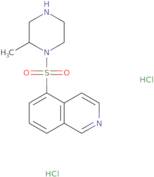
Product Information
- (+/-)-1-(5-Isoquinolinesulfonyl)-2-Methylpiperazine 2Hcl
- (+/-)-1-(5-Isoquinolinesulfonyl)-2-Methylpiperazine Dihydrochloride
- (+/-)-1-(5-Isoquinolinesulphonyl)-2-Methylpiperazine Dihydrochloride
- (-)-1-(5-Isoquinolinesulfonyl)-2-Methylpiperazine, Di-Hcl Salt
- (3R)-4-(isoquinolin-5-ylsulfonyl)-3-methylpiperazin-1-ium
- (3S)-4-(isoquinolin-5-ylsulfonyl)-3-methylpiperazin-1-ium
- 1-(5-Isoquinolinylsulfonyl)-2-Methyl-Piperazine Dihydrochloride
- 5-[(2-Methylpiperazin-1-Yl)Sulfonyl]Isoquinoline Dihydrochloride
- 5-[(2-Methylpiperazin-1-Yl)Sulfonyl]Isoquinoline Hydrochloride
- H-7
- See more synonyms
- Isoquinoline, 5-[(2-methyl-1-piperazinyl)sulfonyl]-, hydrochloride (1:2)
- Piperazine, 1-(5-isoquinolinylsulfonyl)-2-methyl-, dihydrochloride
- H 7 dihydrochloride
H-7 is a cytostatic agent that inhibits the activation of transcription by inhibiting the synthesis of DNA and RNA. H-7 has shown to be an effective inhibitor of epidermal growth factor and α subunit, which are involved in the proliferation of cancer cells. In addition, H-7 can inhibit calcium ion influx into the cell, which may cause cell death. This drug also has potent inducers effects on primary cells, such as HL-60 cells, and induces apoptosis in carcinoma cell lines. H-7 is not an inhibitor of cyclase activity but enhances it when added with guanine nucleotide binding proteins (G proteins) activators such as forskolin. This leads to increased levels of cyclic AMP. As a result, H-7 inhibits protein synthesis and activates cytosolic calcium channels.
Chemical properties
Technical inquiry about: 3D-IEA93017 H-7 dihydrochloride
If you want to request a quotation or place an order, please instead add the desired products to your cart and then request a quotation or order from the cart. It is faster, cheaper, and you will be able to benefit from the available discounts and other advantages.





